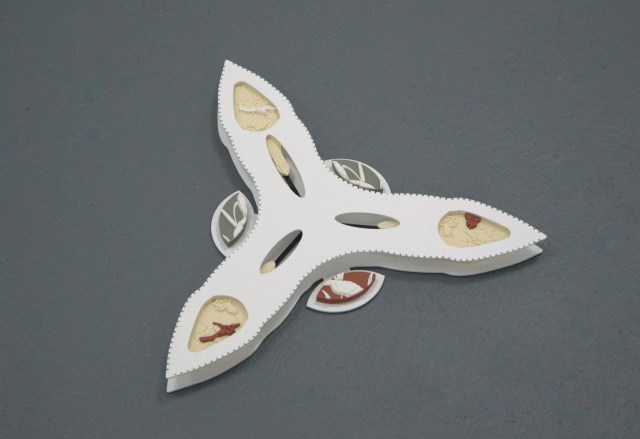Presented by CARBON 12
Seeded Futures, Arboreal Drifts forms part of a larger body of work focusing on colonial botany and Imperial gardens. Colonial botany involved a process of both extraction and erasure – extraction of plants and labour, and erasure of local knowledge. This also involved the transfer of specimens across the globe. Dispersed across three sites: London, Mumbai, and New York, Amba Sayal-Bennett traces the movement of botanical matter across different continents. For her first solo presentation in New York, rubber seeds and taxonomic drawings are followed on a botanical drift, charting stories of exploitation and resistance.
In her reflections on diasporic space, Avtar Brah discusses the entanglement of genealogies of dispersion with those of ‘staying put’. As an artist of British-Asian heritage, Sayal-Bennett is interested in this simultaneous condition of connection and estrangement associated with histories of migration, their intergenerational affects and transfers. Plants are typically thought of as sessile, however they participate in different kinds of movements. Works like Silo recall processes of seeding, one of the many ways in which plants can move matter, whilst Aril, Anigo, and Hilum centre human-assisted movements, abstracting forms from botanical drawings of Hevea Brasiliensis, more commonly known as the rubber plant. Rubber’s usefulness led to its transfer and proliferation. By 1873 the price of rubber had surpassed the price of silver. Wanting to generate its own stocks of rubber, the British government stole 70,000 rubber seeds from Brazil before deploying them to different colonies, including India, to be cultivated. Sayal-Bennett is interested in the ways in which agentic forces, which were not solely human, operated within these histories of transfer.
The wall-based works take their form from taxonomic drawings of Hevea. These drawings were central to the machinery that monetised plants. Voyages of discovery meant that botanical specimens were acquired and identified by European botanists. However, due to the difficulty in taking back live specimens, illustrations were often made in situ. Sayal-Bennett notes that in these drawings, plants were often shown in isolation from any wider habitat on a blank background, encouraging the European scientific community to encounter them in terms of potential economic exploitation rather than part of a symbiotic ecosystem. She is interested in how the drawings themselves have agency as objects of knowledge, affecting what knowledge is produced. The drawings became a way to encounter, but also active participants in, the production of a system of extraction and circulation. Sayal-Bennett’s sculptures work against these extractive and functionalist histories. Botanical forms are digitally re-drawn to create laser-cut steel structures which encase blank paper sheets. Misuse of the taxonomic drawings becomes a form of disobedience, obstructing their purpose of classification and refusing to enact a prior history of use.
Growth patterns are also central to these works. A seed is a multi-temporal object, a carrier of histories and futures, however these futures are not determined nor fixed. The rubber seeds which were taken to India by the British did not grow. The environment rendered them useless, unable to produce for colonial gain. This example stands against an understanding of nature as passive, a conception which goes hand in hand with the capitalist and colonial notion of nature as a resource to be extracted and controlled. Sayal-Bennett reflects on how the Indian climate and soil formed an insurgent infrastructure that refused to comply, refused to be used, and refused to support the imposed crop. Plants also trace deviant movements. Unlike animals, which follow a plan from conception, growing in a systematic way, plants grow anarchically. Branching or leafing out when activated, their growth is modular, adding architectural complexity through the reiteration of existing units. It is this anarchic or modular growth that underpins Sayal-Bennett’s making process. The works evolve or ‘grow’ through the repetition, manipulation, and subtraction of digitally drawn forms. These botanical units are translated through machine production methods used in combination with organic materials such as paper and 3D printed PLA, a renewable biomass filament made from fermented plant starch like corn, cassava, sugarcane or sugar beet pulp. It is through this process of disordered growth that Sayal-Bennett reappropriates botanical units, central to the grammar of empire, to cultivate alternate futures.
Amba Sayal-Bennett is a British-Indian artist working across drawing, projection, and sculptural installation. She received her BFA from Oxford University and her MA in Sculpture from the Royal College of Art. She was awarded her PhD in Art Practice and Learning from Goldsmiths and has published her practice-based research with Tate Papers. She is currently an Associate Lecturer at Camberwell College of Arts, University of the Arts London. Between January and March 2022, she was The Derek Hill Foundation scholar at the British School at Rome in Italy.
Recent exhibitions include Artists Rooms, Jameel Arts Centre, Dubai (2024); Proposals for a Memorial to Partition, Twelve Gates, Philadelphia (2023); Geometries of Difference, Somerset House, London (2022); Horror in the Modernist Block, IKON, Birmingham (2022); and Tomorrow, White Cube, London (2021).

